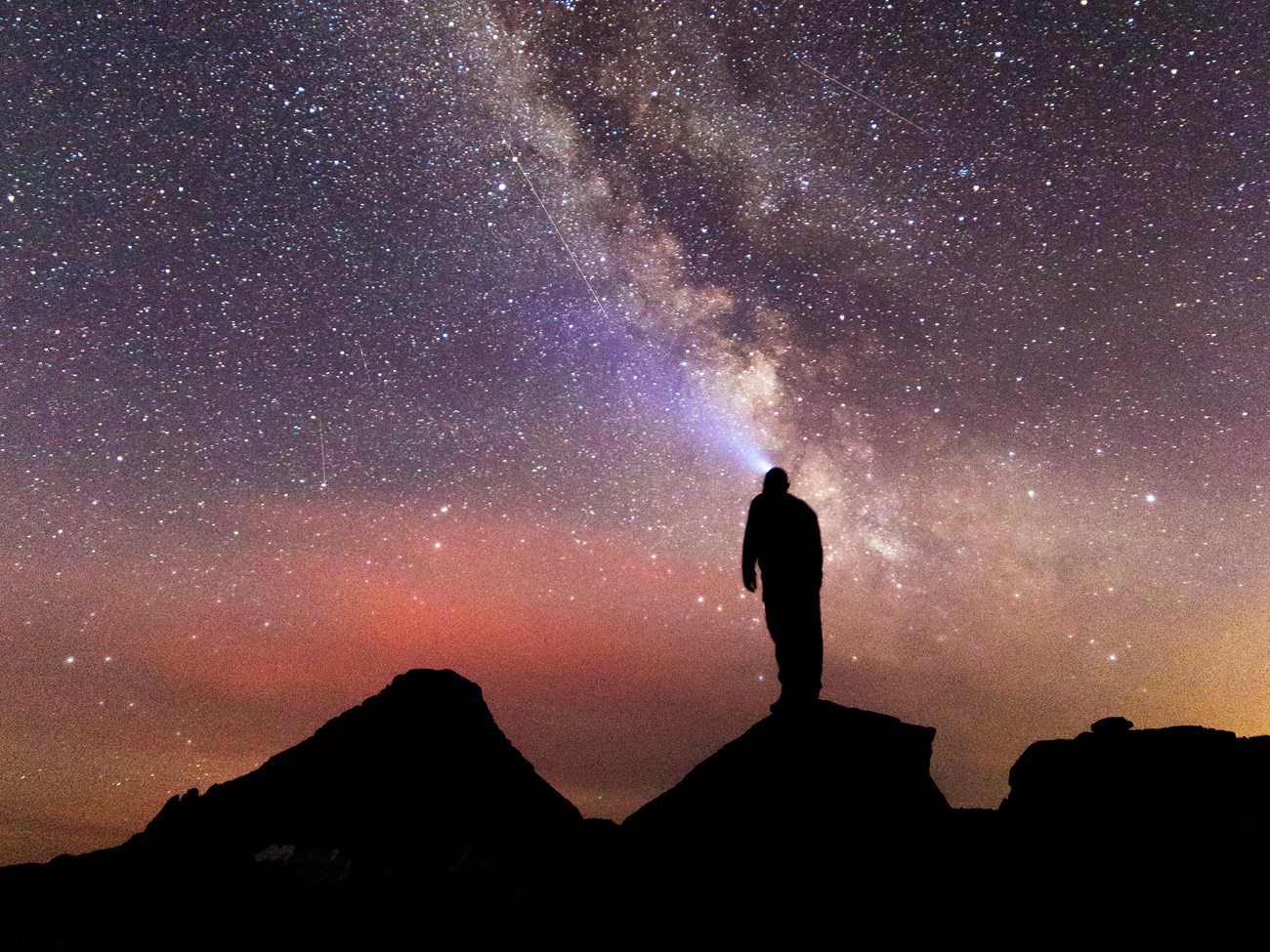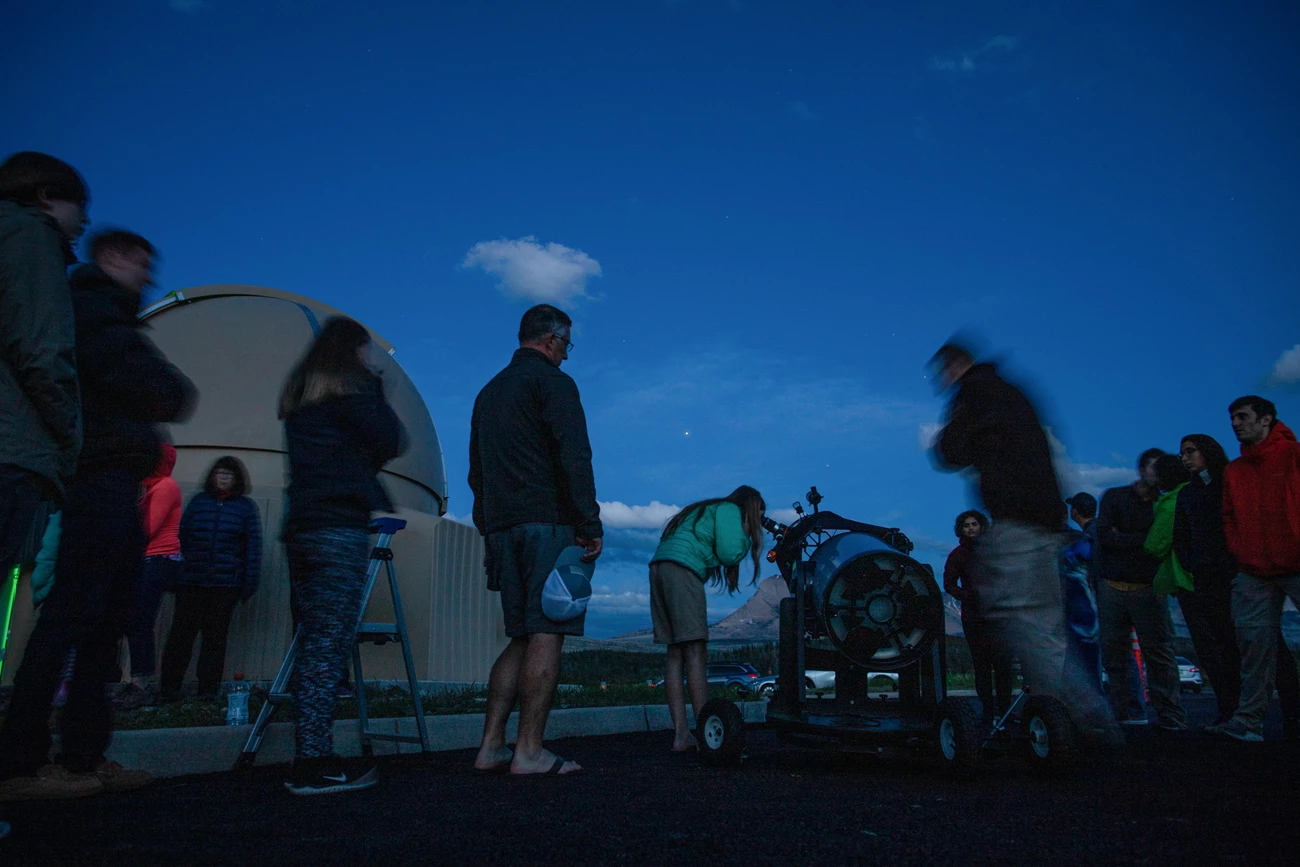Last updated: March 7, 2022
Article
Night Skies Resource Brief
Background Information

Low levels of light pollution in Glacier allow visitors to discover spectacular views of the night sky as well as features like the Milky Way, pictured here.
Threats
Most people in the world live under light-polluted skies, with only 20% able to see the Milky Way at night. Human infrastructure has introduced light in places and times at which it does not naturally occur. The intensity, color temperature, and direction of artificial lights have unintended impacts on the environment. A growing body of research points to adverse effects of light pollution on wildlife, plant development, human health, and energy consumption. Light pollution within parks and protected lands can have a measurable impact upon the habitat quality of the park, even if the light itself originates outside of the park’s administrative boundary. The National Park Service’s Night Skies Team has documented light pollution within some parks, in the form of sky glow, that originated up to 200 miles away.
Dark night skies are essential to the rhythms of life on Earth. Living things evolved with cycles of light and dark, stemming from our planet’s rotation around its axis as it revolves around the sun. For billions of years, dark night skies pervaded–until recently. Through the use of artificial light at night, humans have altered our ability to see the Earth’s dark skies, disrupting the cycle.
Light pollution from human development has a wide range of impacts. Artificial light at night affects the health of animals and plants that rely on natural cues visible only in the dark. Illuminating the night uses large amounts of energy, contributing to climate change. On a more abstract level, eliminating our ability to view the night sky disconnects us from a cultural heritage of using the heavens to navigate, learn about, and interpret our place in the universe.
The International Dark-Sky Association (IDA), founded in 1988, works to mitigate light pollution across the world through education, outreach, and providing resources for policy makers. The IDA offers a designation program to certify and protect places with exemplary night skies. Designated International Dark Sky Places help preserve and protect dark sky sites through responsible lighting policies and public education. These designations bring attention to the importance of protecting dark night skies and provide incentives for both land managers and the public.
Status and Trends
One of the designations the IDA offers is the International Dark Sky Park designation. The IDA defines this status as “a land possessing an exceptional or distinguished quality of starry nights and a nocturnal environment, and that is specifically protected for its scientific, natural, educational, and/or cultural heritage resources, and/or for public enjoyment.” To become an International Dark Sky Park, managers must be able to show strong community support for dark sky protection and meet specific program requirements. A qualifying park should be an exceptional dark sky resource and be accessible to the public at night. The park needs to then meet a series of minimum requirements regarding typical nighttime conditions at the site, establish an outdoor lighting management plan, and commit to dark sky outreach and education.
In 2009, scientists from the National Park Service Night Sky Division measured the quality of Glacier’s night skies at Logan Pass using a measurement called the Anthropogenic Light Ratio. This value compares total sky brightness to natural nighttime light levels. The lower the ALR value, the higher the quality of night sky conditions. The ALR at Logan Pass was 0.17, meaning that the sky there is estimated to be 17 percent brighter than a natural light level—well under the threshold for good conditions as determined by the Night Sky Division. Light readings taken in 2016 at twelve locations throughout Waterton-Glacier registered a magnitude of 21-22 on a Sky Quality Meter. Sky Quality Meters measure the total brightness of the sky in magnitude per square arc-second, on a scale from 7-23, with 23 being the darkest. Waterton-Glacier’s Sky Quality Meter results further indicate an excellent quality of dark night skies.

NPS Photo
Management Strategy
National Park Service management policies emphasize the importance of a natural lightscape to ecosystem function and aesthetics. Dark night skies are valued both as a natural and a cultural feature. They are important to wilderness character and have been identified under the Clean Air Act Amendments as an air quality-related value. Not only do pristine nightscapes enhance visitor experiences, they are also important to wildlife survival and the integrity of the ecosystem.
Waterton-Glacier International Peace Park applied to become a Dark Sky Park in 2016, after working towards this goal since 2006. In 2017, Waterton-Glacier received provisional Gold Tier status as Waterton-Glacier International Dark Sky Park through the IDA. This designation recognizes Waterton-Glacier as the world’s first trans-boundary International Dark Sky Park. Provisional status means that Waterton-Glacier must bring 67% of outdoor lighting into compliance within three years to qualify for full designation, which we anticipate achieving by 2021.
In addition to low levels of light pollution and mitigation of noncompliant lighting, dark sky parks must commit to educating the public about dark sky resources and actively promote the protection of dark skies. Glacier and Waterton provide public opportunities to view the night sky with the help of park and volunteer astronomers. Night sky programs and interpretive materials orient visitors to the park’s dark sky resources, demonstrate their value, and introduce ways to help protect them. Through continued education, retrofitting of light fixtures, and advocacy for dark sky-friendly policies, Waterton-Glacier International Peace Park is committed to protecting and preserving this incredible resource for future generations.
Resources for More Information
Glacier National Park Staff
- Mark Biel, Natural Resources Program Manager
- Lee Rademaker, Astronomy Interpretation Lead
Documents and web sites
- International Dark-Sky Association — http://www.darksky.org
- Indicators and standards of quality for viewing the night sky in the National Parks — https://go.nps.gov/1vvlhs
- NPS Night Skies subject site — https://www.nps.gov/subjects/nightskies/index.htm
- Waterton-Glacier International Dark Sky Park designation press release — https://www.nps.gov/glac/learn/news/media17-12.htm
The Crown of the Continent Research Learning Center
Phone: 406-888-7894; Email: melissa_sladek@nps.gov
Website: www.nps.gov/rlc/crown
